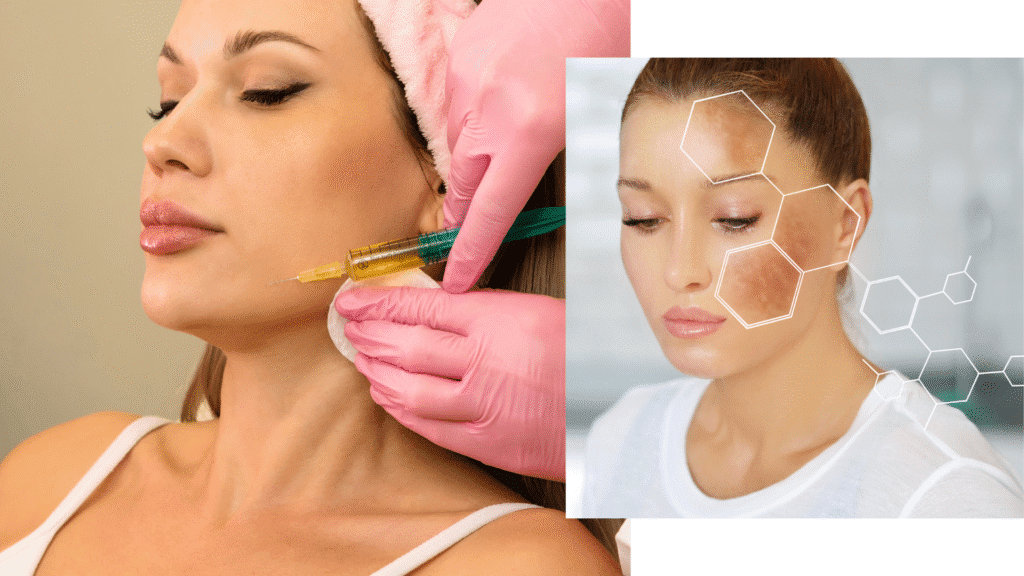
Skin discoloration is a common concern among many individuals, especially in tropical countries like India. Two of the most misunderstood skin issues are melasma and hyperpigmentation. Though they appear similar, their causes, symptoms, and treatments are different.
In this blog, we’ll clearly explain the difference between melasma and hyperpigmentation, how to identify each, and what treatment options are available — including natural Ayurvedic approaches.
What is Hyperpigmentation?
Hyperpigmentation refers to any darkening of the skin caused by an overproduction of melanin, the pigment responsible for skin color.
Common Causes:
Sun exposure
Acne scars
Skin inflammation
Hormonal changes
Injury or burns
Certain medications
Common Types of Hyperpigmentation:
Post-inflammatory hyperpigmentation (PIH) – After acne, eczema, or injury
Sun spots / age spots – From prolonged sun exposure
Freckles – Genetic or sun-induced
What is Melasma?
Melasma is a specific type of hyperpigmentation that appears in symmetric, brownish patches, mostly on the face.
Key Triggers:
Hormonal changes (pregnancy, birth control pills)
Sun exposure
Thyroid disorders
Genetic predisposition
Common Areas Affected:
Cheeks
Forehead
Upper lip
Chin
Nose
Melasma vs Hyperpigmentation: Key Differences
| Feature | Melasma | General Hyperpigmentation |
|---|---|---|
| Cause | Hormonal + Sun Exposure | Inflammation, acne, injury, sun |
| Appearance | Symmetrical brown/gray patches | Uneven dark spots or patches |
| Common Areas | Face (cheeks, nose, forehead) | Anywhere on the body |
| Triggers | Hormones, pregnancy, sunlight | Acne, eczema, cuts, burns, sun |
| Chronic? | Yes, often recurring | Sometimes temporary |
| Treatment Difficulty | More resistant, needs long-term care | Often easier to treat |
Ayurvedic Approach to Melasma and Hyperpigmentation
In Ayurveda, both conditions are linked to Pitta dosha imbalance and accumulation of Ama (toxins) in the skin.
Detox (Shodhana):
Virechana (Purgation therapy) – Removes excess Pitta
Raktamokshana (Bloodletting) – Purifies the blood
Nasya – Helps detoxify the face and improve skin tone
Herbal Support:
Manjistha – Natural blood purifier
Haridra (Turmeric) – Anti-inflammatory, skin-brightening
Aloe Vera (Kumari) – Soothing and cooling for skin
Lodhra, Chandan, and Yashtimadhu – Used in Ayurvedic face packs
Dietary Tips:
Avoid spicy, oily, and acidic foods
Drink coriander or fennel-infused water
Include pomegranate, amla, and turmeric in your diet
Modern Treatments Include:
Chemical peels
Laser therapy
Topical creams (Vitamin C, Hydroquinone, Kojic acid)
Sunscreen (essential for both conditions)
Note: These should be done under dermatological guidance.
Final Thoughts
While melasma is a form of hyperpigmentation, not all hyperpigmentation is melasma. Proper diagnosis is key to choosing the right treatment. Both Ayurveda and modern dermatology offer effective options, but natural, holistic treatment works best for long-term skin healing.
If you’re struggling with pigmentation, consult a qualified skin specialist or Ayurvedic doctor for a customized treatment plan.

